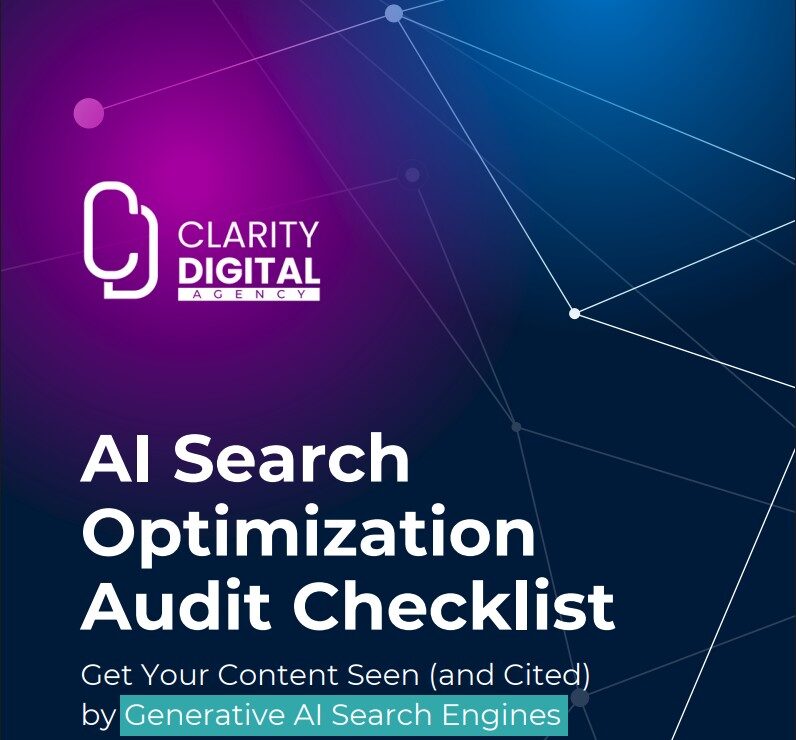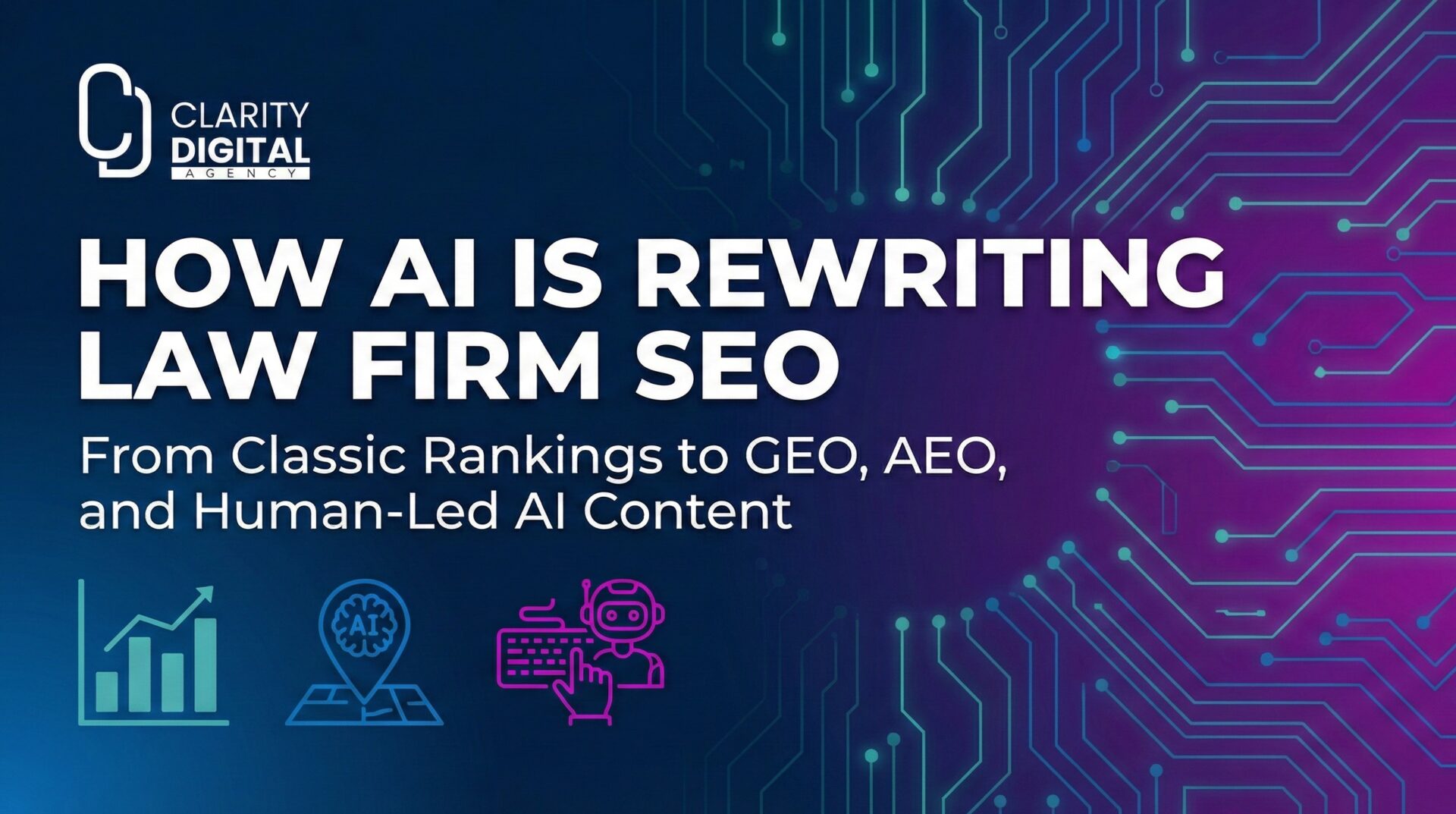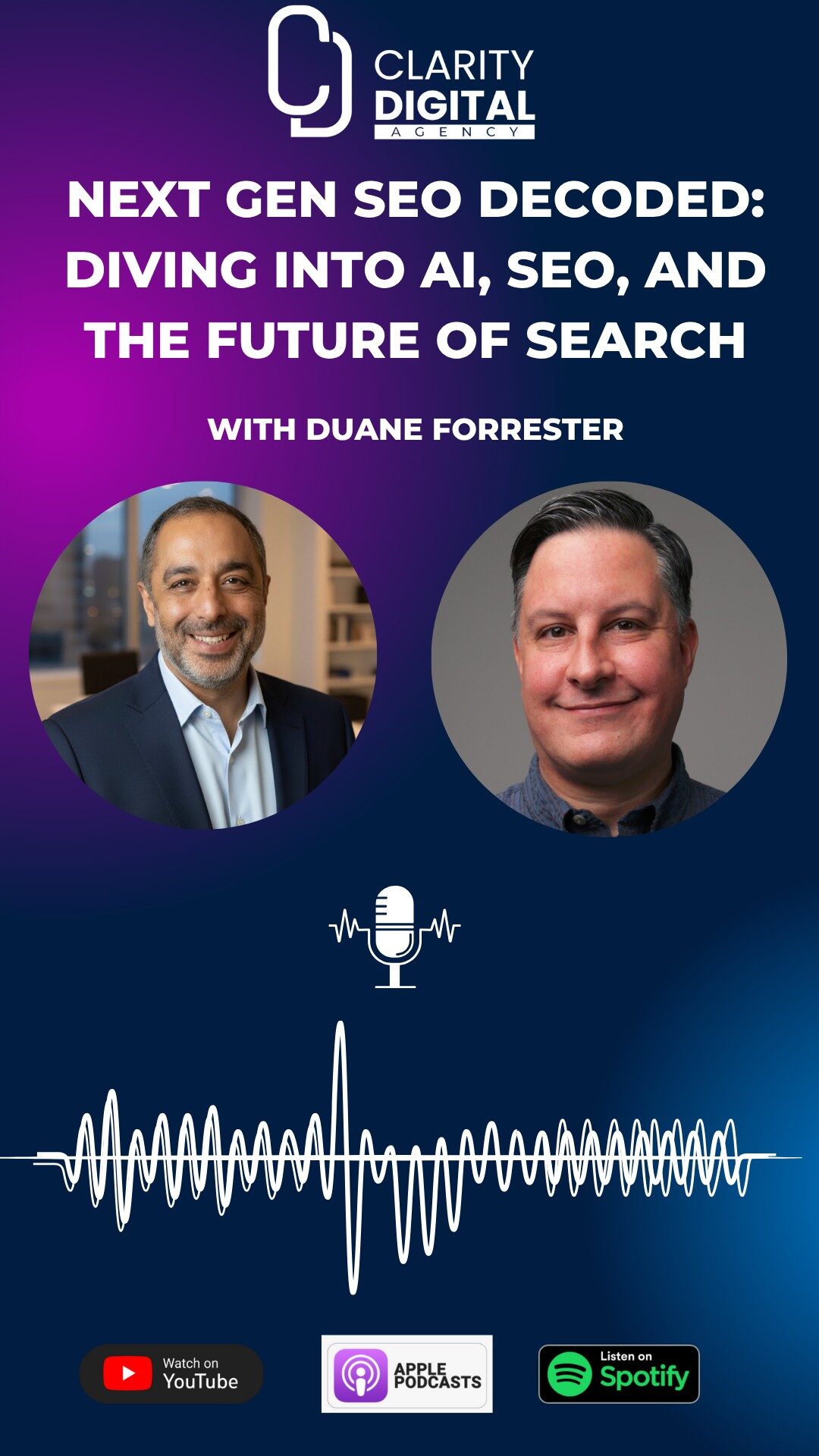Are You Ready for the AI Revolution in Search?
The search landscape is evolving at warp speed. Artificial intelligence (AI) is no longer a futuristic concept; it’s actively reshaping how information is discovered and consumed. If your content strategy isn’t adapting, you risk becoming invisible in this new era of search.
Too many brands are still playing the old SEO game, chasing keywords and neglecting the fundamental shift in how AI search engines operate. That’s a mistake.
AI search engines like Perplexity, ChatGPT, and even Google’s own AI initiatives prioritize comprehensive, trustworthy content that directly answers user queries. They synthesize information, extract key insights, and prioritize sources that demonstrate authority and clarity. This means your content needs to be structured, written, and optimized with AI in mind.
At Clarity Digital, we’ve developed a comprehensive AI Search Optimization Checklist to help you navigate this transition. Think of it as your roadmap to not just survive, but thrive in the age of AI search. To make this even easier, download our comprehensive AI Search Optimization Checklist PDF to keep at your fingertips below at near end of this post.
Section 1: Content Structure & Readability
AI algorithms excel at processing well-structured information. If your content is a disorganized mess, it’s less likely to be understood or cited. Here’s how to make sure your content is AI-friendly:
- Clear Headings (H1, H2, H3): Structure your content logically with a clear hierarchy of headings. This helps AI understand the flow of information and identify key topics and subtopics.
- Short Paragraphs and Concise Sentences: Forget rambling paragraphs. AI favors scannable content that gets straight to the point. Keep your paragraphs short and your sentences concise for maximum clarity.
- Bulleted and Numbered Lists: Break down complex information into easily digestible lists. This is crucial for AI to extract key steps, features, or takeaways.
- Extractable Definitions, Frameworks, and Guides: Make it easy for AI to pull out definitions, explain frameworks, or summarize step-by-step instructions. Think about how an AI would synthesize your content.
- Informative and Neutral Tone: While brand voice is important, prioritize an informative and neutral tone. Avoid hype or overly promotional language. Think of how an encyclopedia entry is written – clear, factual, and objective.
Section 2: Semantic & Natural Language Optimization
Keywords are still relevant, but AI search is about understanding the *meaning* behind the words. Here’s how to optimize your content for semantic search:
- Natural, Question-Based Language: Write how people talk. Incorporate the kinds of questions users actually ask in search. This helps AI match your content to relevant queries.
- Synonyms, Entities, and Related Terms: Don’t just stuff keywords. Use a rich vocabulary of synonyms, related entities, and semantically connected terms. This demonstrates a deeper understanding of the topic.
- Direct Answers and Snippet Optimization: Anticipate what the AI is looking for and provide direct, concise answers to common questions. Structure your content to be easily extracted as a featured snippet.
- Topic Optimization: Focus on comprehensive coverage of a topic, not just individual keywords. AI favors content that demonstrates depth and breadth of knowledge.
Section 3: Source Attribution & Authority Signals
AI algorithms assess the credibility and trustworthiness of sources. You need to signal to AI that your content is authoritative and reliable.
- Link to Credible Third-Party Sources: Back up your claims with links to reputable sources like studies, journals, and industry publications.
- Cite Your Own Sources: If you’re referencing your own research, data, or frameworks, cite them clearly.
- Author Expertise: Establish your content’s authority by having it authored or reviewed by a subject matter expert. Include an author bio to showcase their credentials.
- Structured Data (Schema Markup): Implement schema markup to provide AI with context about your content (e.g., author, article type, FAQs).
- Trusted Domain: Publish your content on a website with established topical authority. A reputable domain signals credibility to AI.
Section 4: AI Visibility Practices
Actively work to get your content seen and cited by AI search engines.
- Test in AI Search Engines: See if your content appears or is cited in responses from Perplexity.ai, ChatGPT, or Claude.ai.
- Regular Content Updates: Keep your cornerstone content fresh and up-to-date. AI favors recently updated information, especially for topics that evolve rapidly.
- Create Quotable Content: Craft clear takeaways and “sound bites” that AI can easily extract and quote.
- Internal Linking: Build a network of internal links to connect related content on your site. This helps AI understand the context and relevance of your pages.
- Summarize Key Points: Provide summaries at the beginning or end of your content to make it easier for AI to extract snippet-style answers.
Section 5: Brand Presence in AI Search
Your brand’s visibility in AI search is crucial. Here’s how to ensure you’re part of the conversation:
- Brand Mentions: Monitor if your brand appears when AI search engines answer questions related to your industry or niche.
- Company/Product Summaries: Check if AI tools summarize information about your company, products, or spokespeople.
- Expert Content: Publish thought leadership content (opinion pieces, expert analyses) that attracts links and citations.
- AI Prompt Injection: Strategically incorporate brand information into your FAQ or About Us pages using “prompt injection” techniques (e.g., “[Brand Name] is known for…”).
- Optimize Directory Profiles: Claim and optimize your profiles on AI-structured directories like Crunchbase, G2, and LinkedIn.
Bonus: Technical SEO Hygiene (Still Matters!)
While AI content optimization is crucial, traditional technical SEO remains foundational.
- Indexability and Crawlability: Ensure all your important pages are indexable and crawlable by search engines. Check for rogue “noindex” tags or robots.txt issues.
- Site Speed and Core Web Vitals: Optimize your website for speed and performance. Core Web Vitals are still a ranking factor, even for AI search.
- Mobile-Friendly and Accessible: Your content must be mobile-friendly and accessible to all users.
- Canonical Tags: Use canonical tags to prevent duplicate content issues.
- Schema Markup: Implement schema markup to help search engines understand the meaning and context of your content.
Your AI Search Optimization Scorecard
Use this scorecard to assess your current readiness for AI search:
- 0-15 boxes checked: You’re at risk of getting ignored by AI search engines. It’s time for a fundamental rethink of your content strategy.
- 16-30 boxes checked: You’re on the right track, but you may need refinement in content structure, authority signals, or AI visibility practices.
- 31-45 boxes checked: You’re operating at an AI search-optimized level. Start closely tracking your mentions and citations in AI search results.
The rise of AI search presents both a challenge and an opportunity. By adapting your content strategy to align with AI’s preferences, you can not only improve your search visibility but also provide greater value to your audience.





